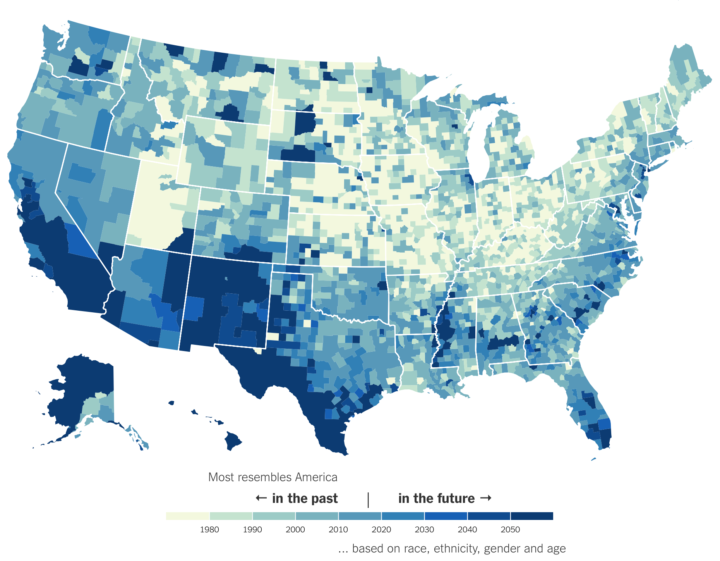I always enjoy the data sketches that Mona Chalabi posts on Instagram. She takes typically everyday data and sketches them or uses props to communicate the actual meaning. Check them out if you aren’t familiar. In her most recent sketch, Chalabi used fruit to compare an empty bladder and stomach to a full bladder and stomach.
-
The relationship and dynamics change. Less lust, more companionship. Is that really how it works?
-
The administration tweeted a chart that shows the Senate Republican health care bill increases Medicaid funding. The line moves up, so it must be true, right? Well, it depends on what you compare to. The original simply compares over time — against the past. Vox compared it against what spending would be under current law.
-
Opting for the force-directed clusters route, Catherine Hanrahan and Simon Elvery for ABC News visualized Australian demographics at the scale of 100 people. Each dot is a person, and as you scroll, you get different breakdowns. It’s percentages, but treating each percentage point as a person makes it more relatable.
See also: Demographics in a world of 100.
-
During the election last year, The New York Times ran an uncertainty dial to show where the vote was swaying. Not everyone appreciated it. Many people hate it. The Outline disliked it enough to troll with an uncertainty dial of their own.
Personally, I like the dial, but I think it does require a certain level of statistical knowledge to not lose your marbles watching it.
-
The Census Bureau released estimates for demographic breakdowns for each county — in 2060. With these estimates as the baseline, Niraj Chokshi and Quoctrung Bui for The Upshot compared it against current population estimates. The result is a map of counties most resembling the past, present, and future.
Clark County, which occupies that corner of Nevada, is the county that most looks like the United States of 2060 in terms of race, Hispanic ethnicity, age and gender, according to new data from the Census Bureau. It was followed by Contra Costa and Solano Counties in California’s Bay Area.
Kind of looks like the inverse of white percentages.
-
Movies would have you believe that birth is random and unpredictable. (And if you haven’t been part of the birth process, you’d be surprised by how slow it actually is.) While uncertainty is always in play, there’s a certain cycle to it all. Zan Armstrong and Nadieh Bremer for Scientific American, using 2014 data from the Centers for Disease Control and Prevention, examined the regularity and the reasons for the spikes.
I like the greater/lesser than average split for contrast. The circle time series layout doesn’t always fit the data, but in this case the metaphor fits the cyclical aspect.
-
We all get a lot of emails, and there’s a large subset of them that almost instantly end up in the archive or the trash bin. In the past year, this subset seems to have really grown for me. They tend to follow a similar pattern to “submit infographic” probably 90 percent of the time. At this point, the patterns seem so regular that I can archive without ever opening the email. Here’s my deletion process.
Read More -
Google released the Quick, Draw! dataset, so the closer looks at the collection of 100,000 sketches are coming in. This fun piece by Yannick Assogba uses principal components to arrange doodles in some organized way.
Reminiscent of Aaron Koblin’s classic The Sheep Market.
-
Open Up: A Guide to Using Open Data to Combat Corruption is free for download.
A broad understanding of corruption recognises that it is not just about isolated acts between two different agents: the one who offers a bribe, and the one who receives it. Instead, corruption is a complex crime. It is driven by networks of officials, professional intermediaries and companies. So in order to tackle corruption effectively, you need to understand and dismantle these networks. This requires information and the ability to spot patterns.
The more people who can find truth in the data, the better we all come out in the end.
-
I had the honor to deliver the commencement speech at the UCLA Statistics graduation this past weekend. I’m going to put this here for posterity before my memory tucks it away never to be uttered again. I truncated the speech last minute, so these notes are a little more coherent than my delivery.
Read More -
Thu-Huong Ha and Nikhil Sonnad for Quartz looked at the doodling dataset from Google, in search of cultural differences hidden in how we draw circles around the world.
We used the public database from Quick, Draw! to compare how people draw basic shapes around the world. Our analysis suggests that the way you draw a simple circle is linked to geography and cultural upbringing, deep-rooted in hundreds of years of written language, and significant in developmental psychology and trends in education today.
Love the added context showing character strokes in different languages.
-
Nerd humor:
Asked for a normal coffee ☕ pic.twitter.com/JoakebV9xN
— Matt Moores (@MooresMt) June 14, 2017
That barista deserves a tip.
-
Using Google’s Quick Draw dataset, a collection of 50 million drawings across 345 categories, Mauro Martino looked for visual differences and similarities across countries in how people doodle. The result is his project Forma Fluens.
Read More -
How to Make a Multi-line Step Chart in R
For the times your data represents immediate changes in value.
-
Every now and then there’s a visual exploration of the Choose Your Own Adventure series. It seems that each gets a bit more complex, so I appreciate the simplicity of these official maps from Chooseco, which shows the structure of each book. Atlas Obscura provides the details.
On the official maps, however, the endings aren’t coded in any way that reveals their nature. Instead, they operate according to a simple key: each arrow represents a page, each circle a choice, and each square an ending. Dotted lines show where branches link to one another.
The one above is for Journey Under the Sea. I need to dig up my CYOA collection.
-
Ice in Antartica is in constant (very slow) motion, and as ocean waters warm, the flow of ice accelerates. The New York Times mapped the flows, showing where the ice is headed.
And, if you’re interested in how they did this, NYT graphics editor Derek Watkins provides the rundown.
-
As expected, this time, the Golden State Warriors won the championship last night.…
-
Jane Solomon collected tweets that used the gun emoji, and looked at what emojis were used before and after as a way to see how people used the gun.
It seems that the sarcastic and reflexive gun emoji pairings are extremely popular, which matches my expectations and the knowledge I brought into this exercise. One result that surprised me was the high collocation with the gun and various heart emoji. I had never personally associated the gun emoji as a means to express heartbreak, but it’s there in the data.
[via Waxy]

















 Visualize This: The FlowingData Guide to Design, Visualization, and Statistics (2nd Edition)
Visualize This: The FlowingData Guide to Design, Visualization, and Statistics (2nd Edition)










